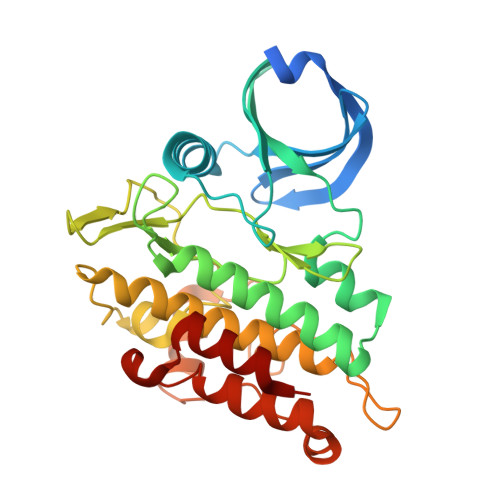An ALK2 inhibitor, BLU-782, prevents heterotopic ossification in a mouse model of fibrodysplasia ossificans progressiva.
Davis, A.J., Brooijmans, N., Brubaker, J.D., Stevison, F., LaBranche, T.P., Albayya, F., Fleming, P., Hodous, B.L., Kim, J.L., Kim, S., Lobbardi, R., Palmer, M., Sheets, M.P., Vassiliadis, J., Wang, R., Williams, B.D., Wilson, D., Xu, L., Zhu, X.J., Bouchard, K., Hunter, J.W., Graul, C., Greenblatt, E., Hussein, A., Lyon, M., Russo, J., Stewart, R., Dorsch, M., Guzi, T.J., Kadambi, V., Lengauer, C., Garner, A.P.(2024) Sci Transl Med 16: eabp8334-eabp8334
- PubMed: 38809966
- DOI: https://doi.org/10.1126/scitranslmed.abp8334
- Primary Citation of Related Structures:
8UWN, 8UWR - PubMed Abstract:
Fibrodysplasia ossificans progressiva (FOP) is a rare genetic disease driven by gain-of-function variants in activin receptor-like kinase 2 (ALK2), the most common variant being ALK2 R206H . In FOP, ALK2 variants display increased and dysregulated signaling through the bone morphogenetic protein (BMP) pathway resulting in progressive and permanent replacement of skeletal muscle and connective tissues with heterotopic bone, ultimately leading to severe debilitation and premature death. Here, we describe the discovery of BLU-782 (IPN60130), a small-molecule ALK2 R206H inhibitor developed for the treatment of FOP. A small-molecule library was screened in a biochemical ALK2 binding assay to identify potent ALK2 binding compounds. Iterative rounds of structure-guided drug design were used to optimize compounds for ALK2 R206H binding, ALK2 selectivity, and other desirable pharmacokinetic properties. BLU-782 preferentially bound to ALK2 R206H with high affinity, inhibiting signaling from ALK2 R206H and other rare FOP variants in cells in vitro without affecting signaling of closely related homologs ALK1, ALK3, and ALK6. In vivo efficacy of BLU-782 was demonstrated using a conditional knock-in ALK2 R206H mouse model, where prophylactic oral dosing reduced edema and prevented cartilage and heterotopic ossification (HO) in both muscle and bone injury models. BLU-782 treatment preserved the normal muscle-healing response in ALK2 R206H mice. Delayed dosing revealed a short 2-day window after injury when BLU-782 treatment prevented HO in ALK2 R206H mice, but dosing delays of 4 days or longer abrogated HO prevention. Together, these data suggest that BLU-782 may be a candidate for prevention of HO in FOP.
Organizational Affiliation:
Blueprint Medicines Corporation, Cambridge, MA 02139, USA.




















